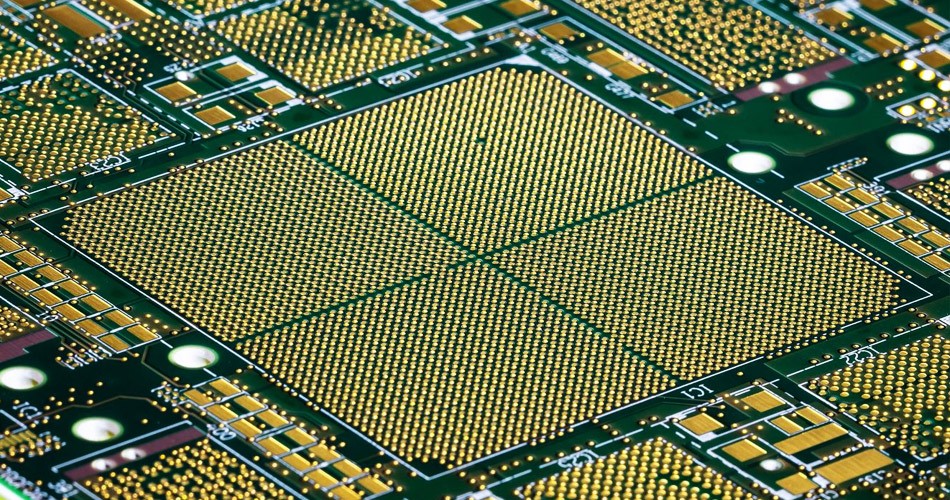
Shenzhen 开云·kaiyun官方网站 manufacturer will explain to you the analysis of the short boards of AmerICan semiconductor in the future
Although there are different opinions about which industry is the "crown" of modern industry, there is no doubt that the sEMIconductor industry plays an important role in today's major industrial countries. Especially since the chip shortage crisis started in 2021, the importance of semiconductor has begun to emerge, and has been recognized by various social departments. There are many discussions at the government level, and it has also become a topic in the MARKet.
However, semiconductor is a highly complex industry, which not only leads other industries in terms of capital intensity, but also surpasses software and Internet industries in terms of R&D intensity, and is close to biotechnology and pharmaceutical industries that are recognized as having a large R&D investment. According to the statistics in 2019, the capital investment and R&D investment of semiconductor enterprises reached US $110 billion and US $90 billion respectively, almost half of the total industry revenue of the year (US $419 billion).

It can be seen that the semiconductor industry can not only significantly promote the local economic development, but also greatly strengthen the talent structure here and boost the local development competitiveness as a whole. Therefore, major industrial countries and economic communities have strengthened their research on the semiconductor industry, trying to fundamentally understand the development status, competitive weaknesses and growth direction of the semiconductor industry within their borders. As the pioneer and leader of this industry, American people of insight are no exception.
Since the appearance of semiconductor shortage, many think tanks and research institutions, including KPMG, GSA and ITIF, have begun to focus on the local semiconductor industry in the United States. The American Semiconductor Industry Association (SIA), in collaboration with Boston Consulting Group (BCG), has released a series of research reports and lectures on the local semiconductor industry in the United States, including industry status American competitiveness and development advice. SIA also made active suggestions when the US Department of Commerce investigated the semiconductor supply chain last year, aiming to strengthen the semiconductor industry ecosystem and ensure that the US continues to lead the industry. This article allows us to sort out how US think tanks have felt the pulse of their local semiconductor industry.
U.S. Advantages
First of all, the United States is a well-known industrial core country, with the largest number of leading chip companies, contributing 47.2% of the total industry revenue. In 2020, semiconductor companies headquartered in the United States will achieve a total revenue of 207.9 billion US dollars, with a compound annual growth rate of 3.62%. American semiconductor companies occupy a dominant market position in China, the Asia Pacific region outside China and Japan, as well as the European market, and occupy a comparative advantage in their own country and Japan.
The United States has become the industry leader because of its leading position in many links of the semiconductor industry chain. On the whole, American companies account for 38% of the semiconductor value chain, especially in research and development intensive subdivisions such as EDA software, core IP, semiconductor production equipment, and digital and analog chip design. American companies have absolute or comparative advantages. In the capital intensive or labor intensive sub sectors, the United States gives way to East Asian countries and regions that can obtain more government incentives.
In addition to continuous R&D investment, the United States has also benefited from the contributions of a large number of local and foreign talents in the past. The profound talent reserve allows the United States to have enough brain power to invest in semiconductor basic research and application research, and rely on it to carry out competitive product development. Nvidia and its founder Huang Renxun are the best examples.
According to statistical data, the annual growth rate of R&D investment of American semiconductor companies reached 7.2%. In 2020 alone, they invested a total of $44 billion, accounting for 18.6% of the company's revenue. Vertically, this R&D investment ratio is second only to the biomedical industry in all industries in the United States, but horizontally, it is far more than that of peers in other countries and regions.
Therefore, the United States has become a source of innovation in semiconductor technology, producing a large number of technical patents and research papers. Although not the largest in total, the average number of citations of semiconductor patents in the United States is 3-6 times that in other countries. In addition, judging from the proportion of ternary patents (referring to patents registered in the United States, Europe and Japan, which are generally considered as the symbol of high-quality innovation with global business potential), the U.S. R&D strength and R&D achievements in the semiconductor field also far exceed those of other countries and regions except the EU.
A large amount of R&D and capital investment has also made the labor productivity of the US semiconductor industry continuously rise, nearly double that of 20 years ago. Take 2020 as an example, the per capita revenue of American chip enterprises will exceed 571000 dollars.
To make a SIMple comparison with figures, the per capita investment in R&D and fixed assets of American semiconductor companies will be $176000 in 2020, with an annual growth rate of 3.5%. If competitors from other countries cannot approach or exceed US $176000 in this index calculated according to purchasing power parity, they can only make up in other aspects to catch up with or catch up with the technological progress of the United States.
Shortcomings of the United States
However, in the global semiconductor trade flow, the United States is not in line with its size. One reason is that most of the manufacturing departments of American semiconductor companies are located overseas, or they use Asian OEM factories. The domestic Chip Manufacturing capacity of the United States has decreased from 37% of the world's total capacity in 1990 to 12% today. At present, the domestic business of American chip companies is mainly focused on design and marketing, making little contribution to trade volume.
In addition, although the strength of China's domestic semiconductors needs to be strengthened, based on China's outstanding position in the manufacturing and assembly of electronic equipment, most of the finished semiconductors, or chips, have gone to China's manufacturing sector, making China the hub of the actual semiconductor trade.
The decline of domestic semiconductor manufacturing in the United States is due to the fact that the United States has certain disadvantages compared with other countries and regions in some key factors for building a wafer factory. For example, government subsidies and incentive policies have a significant impact on the establishment and operation of a wafer factory. For cutting-edge manufacturing processes, support from all levels of government can account for 16% - 38% of the total cost of ownership (TCO) of a wafer factory in 10 years. Therefore, according to BCG's calculation, the TCO of the US local wafer fabs is 25% - 50% higher than that of other countries and regions.
In addition to direct subsidies for production, the US government also shows weak support for semiconductor research and development. In 2018, federal government subsidies accounted for 13% of the US semiconductor industry's R&D expenditure, covering basic research, application research and product development. However, the average for other industries is 22%. At the same time, in the past 40 years, the proportion of US government subsidies for semiconductor R&D in US GDP has almost remained unchanged, while the proportion of private sector investment in semiconductor R&D in GDP has increased by 10 times in the same period. This also makes other countries, especially China, gradually narrow the gap with the United States in R&D spending.
At the same time, the US semiconductor industry is gradually catching up with and surpassing the past solid talent pool: the growth rate of science and engineering talents graduated from China each year is more than 10%, while the growth rate in the US is less than 3%. In addition, a large number of science and engineering talents in the United States are transferred to the Internet industry with higher income. Taking my company as an example, there are only a few new engineers under the age of 30. In addition, the talent competition between the United States and other countries and regions has become increasingly fierce, leading to the inflow of overseas talents in the United States is also less than before, especially professionals from East Asia.
Changes in the United States
In order to reverse these unfavorable situations, the political and industrial circles in the United States have constantly calLED for strengthening the semiconductor industry and returning chip manufacturing to the United States. The U.S. Senate passed the U.S. Innovation and Competition Act (USICA) (S.1260) in the middle of 2021, including a $52 billion federal budget for the CHIPS for America Act. At the beginning of this year, the U.S. House of Representatives passed the American Competites Act of 2022, which also includes 52 billion dollars for strengthening the U.S. semiconductor industry, including 39 billion dollars for stimulating local semiconductor manufacturing and research and development, and 10.5 billion dollars for project funds.
Although the Senate and the House of Representatives still have differences on these two bills, there is little dispute about the "chip bill" that provides funds for the semiconductor industry. In addition, as a supplement to the CHIPS Act, the House of Representatives also passed the Promotion of Semiconductors Made in America (FABS) Act this month to provide tax credits for semiconductor investment.
It seems like a lot of $52 billion, but if we want to build a fully self-sufficient chip manufacturing capacity in the United States, it will only be a drop in the bucket. Based on the U.S. semiconductor consumption in 2019, 60-64 new wafer plants will be needed to meet all the semiconductor categories required by the United States in that year, and the investment will exceed trillion dollars in 2021-2030. Taking into account the high operating costs of American wafer factories, the local production of low-cost chips does not conform to reality economically.
However, considering that memory, discrete and analog devices, and low-end logIC chips only need traditional or mature manufacturing processes, the United States can easily obtain this "backward" capacity from other countries and regions to meet its own needs. Therefore, only high-end chips that require cutting-edge manufacturing processes, such as CPU, GPU and FPGA, are worthy of US investment in local production capacity. Similarly, according to the consumption in 2019, we only need to invest 200 billion US dollars to build 6-7 cutting-edge wafer fabs to meet the demand.
Further diSMAntle the demand for such high-end chips in the United States, more than two-thirds of which come from consumer electronics and general infrastructure needs. The chip requirements of these non critical applications can also be realized through outsourcing. The domestic semiconductor production capacity of the United States only needs to meet the demand for some cutting-edge process chips in key areas such as defense and aerOSPace, telecommunications networks, government and important department data centers, which only accounts for 9% of the total semiconductor consumption in the United States.
For the government and the private sector, this also means that good steel can be used for cutting edges - only $45 billion of industry investment and $18 billion of government subsidies are needed to establish two or three 12 inch wafer factories with a capacity of 20000 to 35000 chips per month, which can achieve "chip security" in the United States. Compared with the flood of industries that cannot be realized, US policymakers and investors can completely use US $52 billion of government grants to subsidize the self hemopoiesis of US semiconductor.
At present, many semiconductor manufacturers and manufacturers have made bets on manufacturing in the United States. Intel invested 20 billion dollars in Phoenix, Arizona, to build two new factories, and then announced that 100 billion dollars in Ohio would be the largest chip manufacturing park in the world.
Intel's overseas competitors are not to be outdone. TSMC, a wafer foundry giant, invested $12 billion in the construction of a 5-nanometer Arizona factory, which is planned to be completed and put into operation in 2024. TSMC also expects to establish up to 6 wafer plants in the state in the next 10-15 years. Samsung Electronics also announced plans to build a $17 billion plant in Texas.
The ensuing dispute is whether foreign enterprises such as TSMC and Samsung Electronics can get a piece of the US $52 billion subsidy from the US government. In any case, from the current investment plan, there are 2-3 cutting-edge manufacturing wafer factories in the United States, which is highly likely to achieve self-sufficiency in chips used in key areas.
At the same time, the battle for semiconductor professionals began. According to a joint report released by KPMG and the Global Semiconductor Alliance (GSA) in March 2022, 88% of semiconductor companies (half of which are American enterprises) will increase the number of employees in the next year, of which 34% believe that the range will exceed 10%. In the face of the "Great Resignation" in the United States since 2021, 77% of 152 senior executives interviewed in the semiconductor industry believe that the company's top priority strategy in the next three years is to recruit, cultivate and retain talents.
According to the data observed by the author in an anonymous professional social app in Silicon Valley, recently leading companies in the industry such as Intel, AMD, Broadcom and Meiman Semiconductor have significantly increased the salary level of new employees, and some of them are even equal to Internet companies such as FAANG.
Finally, in order to strengthen itself and weaken its competitors, the United States has also set obstacles for China and Europe to invest in American semiconductor companies. In particular, FDI in foreign direct investment between China and the United States has decreased significantly. According to Bain Capital's data, FDI decreased from US $62 billion in 2016 to US $16 billion, with a more significant decline in technology investment, reaching 96%. The United States also has long arm jurisdiction over foreign companies' acquisition of American companies, even non American companies, through CFIUS policies and reviews. For example, it does not approve Infineon, a German semiconductor company, to acquire Cree's silicon carbide business, and recently rejected China Zhilu Capital's acquisition of Korean semiconductor company Magnachip
Summary
The United States is a well deserved champion in the semiconductor industry, especially in the R&D intensive subdivisions. However, the semiconductor manufacturing outsourcing and talent supply decrease for many years, which makes the semiconductor industry in the United States lack stamina. In recent years, some measures taken by the US political circles and the industry have attempted to achieve self-sufficiency in semiconductor in key areas, and have made talent acquisition the focus of semiconductor companies' future development.
然后
联系
电话热线
13410863085Q Q

微信

- 邮箱











